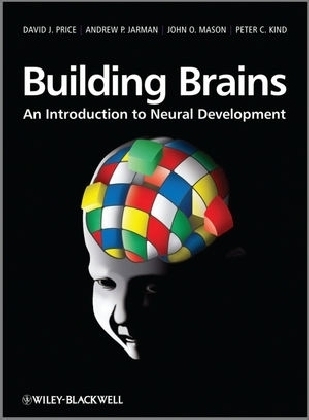
Building Brains
Wiley-Blackwell (Verlag)
978-0-470-71230-6 (ISBN)
- Titel ist leider vergriffen;
keine Neuauflage - Artikel merken
Aimed at undergraduate students and postgraduates new to the field, who may not have a background in neuroscience and/or molecular genetics, it explains how cells in the early embryo first become neural, how their proliferation is controlled, what regulates the types of neural cells they become, how neurons connect to each other, how these connections are later refined under the influence of neural activity including that arising from experience, and why some neurons normally die. Key Features: * A concise illustrated guide focusing on the core elements of current understanding of neural development, emphasising common principles underlying developmental mechanisms and supplemented by suggestions for further reading. * Text boxes throughout provide further detail on selected major advances, issues of particular uncertainty or controversy and examples of human diseases that result from abnormal development. * A balanced mammalian/non-mammalian perspective, drawing on examples from model organisms including the fruit fly, nematode worm, frog, zebrafish, chick, mouse, ferret, cat, monkey and human, and emphasising mechanisms that are conserved across species.
* Introduces the methods for studying neural development including genetics, transgenic technologies, advanced microscopy and computational modeling, allowing the reader to understand the main evidence underlying research advances. * Student-friendly, full colour artwork reinforces important concepts; an extensive glossary and definitions in page margins help readers from different backgrounds; chapter summaries stress important points and aid revision. * Associated Website includes a complete set of figures from the textbook.
David Price is Professor of Developmental Neurobiology, University of Edinburgh. Andrew Jarman is Professor of Developmental Biology, Centre for Integrative Physiology, University of Edinburgh. John Mason is Reader, Centre for Integrative Physiology, University of Edinburgh. Peter Kind is Reader, University of Edinburgh.
Preface. Conventions and Commonly used Abbreviations. 1 Models and Methods for Studying Neural Development. 1.1 What is neural development? 1.2 Why research neural development? 1.3 Major breakthroughs that have contributed to understanding developmental mechanisms. 1.4 Invertebrate model organisms. 1.5 Vertebrate model organisms. 1.6 Observation and experiment: methods for studying neural development. 1.7 Summary. 2 The Anatomy of Developing Nervous Systems. 2.1 The nervous system develops from the embryonic neuroectoderm. 2.2 Anatomical terms used to describe locations in embryos. 2.3 Development of the neuroectoderm of invertebrates. 2.4 Development of the neuroectoderm of vertebrates and the process of neurulation. 2.5 Secondary neurulation in vertebrates. 2.6 Formation of invertebrate and vertebrate peripheral nervous systems. 2.7 Summary. 3 Neural Induction: An Example of How Intercellular Signalling Determines Cell Fates. 3.1 What is neural induction? 3.2 Specification and commitment. 3.3 The discovery of neural induction. 3.4 A more recent breakthrough: identifying molecules that mediate neural induction. 3.5 Conservation of neural induction mechanisms in Drosophila. 3.6 Beyond the default model other signalling pathways involved in neural induction. 3.7 Signal transduction: how cells respond to intercellular signals. 3.8 Intercellular signalling regulates gene expression. 3.9 The essence of development: a complex interplay of intercellular and intracellular signalling. 3.10 Summary. 4 Patterning the Neuroectoderm. 4.1 Regional patterning of the nervous system. 4.2 Patterning the anteroposterior (AP) axis of the Drosophila CNS. 4.3 Patterning the AP axis of the vertebrate CNS. 4.4 Refining AP axis patterning within regions and segments. 4.5 Patterning the dorsoventral (DV) axis of the nervous system. 4.6 Bringing it all together. 4.7 Summary. 5 Neurogenesis: Generating Neural Cells. 5.1 Generating neural cells. 5.2 Neurogenesis in Drosophila. 5.3 Neurogenesis in vertebrates. 5.4 The regulation of neuronal subtype identity. 5.5 The regulation of cell proliferation during neurogenesis. 5.6 Temporal regulation of neural identity 5.7 Why do we need to know about neurogenesis? 5.8 Summary. 6 Neuronal Migration. 6.1 Many neurons migrate long distances during formation of the nervous system. 6.2 How can neuronal migration be observed? 6.3 Major modes of migration. 6.4 Initiation of migration. 6.5 How are migrating cells guided to their destinations? 6.6 Locomotion. 6.7 Journey s end termination of migration. 6.8 The mechanisms that govern migration of important populations of cortical neurons remain unknown. 6.9 Summary. 7 How Neurons Develop Their Shapes. 7.1 Neurons form two specialized types of outgrowth. 7.2 The growing neurite. 7.3 Stages of neurite outgrowth. 7.4 Neurite outgrowth is influenced by a neuron's surroundings. 7.5 Molecular responses in the growth cone. 7.6 Active transport along the axon is important for outgrowth. 7.7 The development of neuronal polarity. 7.8 Dendrites. 7.9 Summary. 8 Axon Guidance. 8.1 Many axons navigate long and complex routes. 8.2 The growth cone. 8.3 How might axons be guided to their targets? 8.4 Breaking the journey intermediate targets. 8.5 Contact guidance. 8.6 Guidance of axons by diffusible cues chemotropism. 8.7 How do axons change their behaviour at choice points? 8.8 How can such a small number of cues guide such a large number of axons? 8.9 Some axons form specific connections over very short distances, likely using different mechanisms. 8.10 The growth cone has autonomy in its ability to respond to guidance cues. 8.11 Transcription factors regulate axon guidance decisions. 8.12 Summary. 9 Map Formation. 9.1 What are maps? 9.2 Types of maps. 9.3 Principles of map formation. 9.4 Development of coarse maps: cortical areas. 9.5 Development of fine maps: topographic. 9.6 Inputs from multiple structures: when maps collide. 9.7 Development of feature maps. 9.8 Summary. 10 Maturation of Functional Properties. 10.1 Neurons are excitable cells. 10.2 Neuronal excitability during development. 10.3 Developmental processes regulated by neuronal excitability. 10.4 Synaptogenesis. 10.5 Spinogenesis. 10.6 Summary. 11 Life and Death in the Developing Nervous System. 11.1 The frequency and function of cell death during normal development. 11.2 Cells die in one of two main ways: apoptosis or necrosis. 11.3 Studies in invertebrates have taught us much about how cells kill themselves. 11.4 Most of the genes that regulate programmed cell death in C. elegans are conserved in vertebrates. 11.5 Examples of neurodevelopmental processes in which programmed cell death plays a prominent role. 11.6 Neurotrophic factors are important regulators of cell survival and death. 11.7 A role for electrical activity in regulating programmed cell death. 11.8 Summary. 12 Experience-Dependent Development. 12.1 Effects of experience on visual system development. 12.2 How does experience change functional connectivity?. 12.3 Cellular basis of plasticity: development of inhibitory networks. 12.4 Homeostatic plasticity. 12.5 Structural plasticity and the role of the extracellular matrix. 12.6 Summary. Suggestions for Further Reading. Glossary. Index.
| Erscheint lt. Verlag | 16.5.2011 |
|---|---|
| Verlagsort | Hoboken |
| Sprache | englisch |
| Maße | 206 x 267 mm |
| Gewicht | 1134 g |
| Themenwelt | Medizin / Pharmazie ► Medizinische Fachgebiete ► Neurologie |
| Naturwissenschaften ► Biologie ► Humanbiologie | |
| Naturwissenschaften ► Biologie ► Zoologie | |
| ISBN-10 | 0-470-71230-9 / 0470712309 |
| ISBN-13 | 978-0-470-71230-6 / 9780470712306 |
| Zustand | Neuware |
| Informationen gemäß Produktsicherheitsverordnung (GPSR) | |
| Haben Sie eine Frage zum Produkt? |
aus dem Bereich



